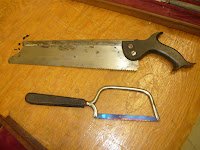The box has a hinged lid and two shelves inside. On the bottom is a green rough cloth, most of which is worn off. Inside it is lined with deep red velvet and has indentations for the equipment it carries.

The first shelf contains clippers, a puller, a tenaculum, and a knife. The clippers are made of metal and have sharp cutting edges. The puller is metal as well with vise shaped teeth. Both have two handles in order to get a good tight grip.

The knife shown below is metal with a rubber handle. The rubber is not smooth so that even if the surgeon's hands were sweaty or covered in blood, he would not lose his grip. This knife was used to cut through flesh and muscle, down to the bone.
The bottom shelf has two saws and a spiral tourniquet. The cloth was wound around the limb and the spiral was turned to tighten it as much as possible in order to stop the bleeding. Once the knife had done its work, the surgeon would then use the large saw to cut through the bone and finish amputating the limb. The smaller saw was used for smaller bones.
The tenaculum shown below is made of wood and metal and was used to pull
arteries out of the stump once a limb had been amputated so they could be tied off and stop bleeding.
So, next time you see volunteers fund raising for hospitals, remember this equipment. Thank goodness amputations are not as common today, but if they are necessary, these tools stay in the museums and out of the operating rooms.
























